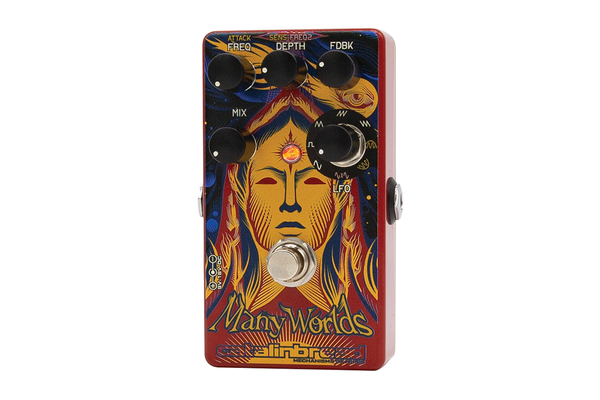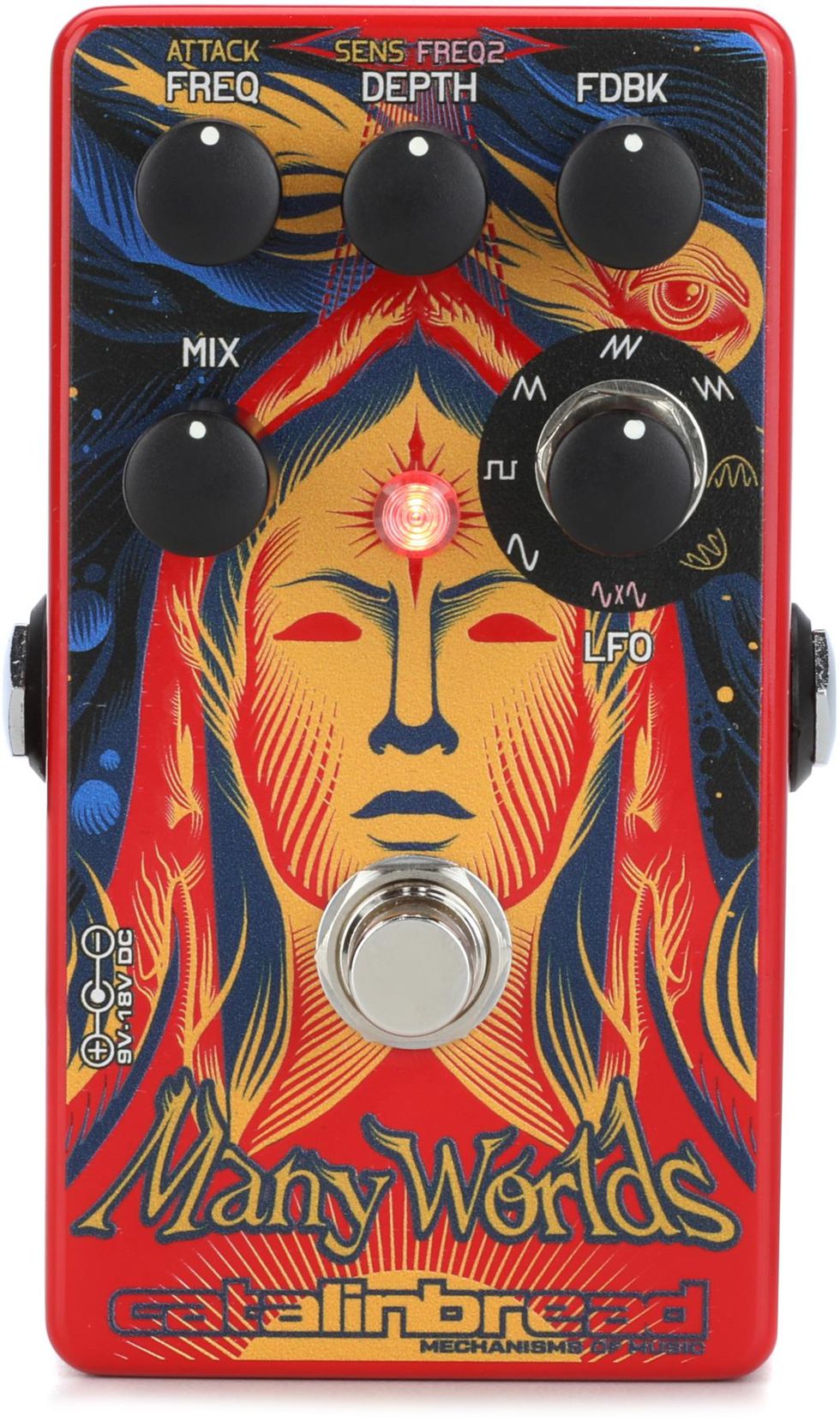Named after physicist Hugh Everett III’s quantum-mechanics theory of the multiverse, the Catalinbread’s Many Worlds phaser takes a tonal trajectory arcing back to the mid-’70s Phase 90 and fractures it, Schrödinger’s cat-style, with eight stages and eight LFO modes. Five knobs govern up to eight parameters and five traditional LFO types—sine, square, sawtooth, reverse-sawtooth, and triangle—plus two envelope-dependent sine modes that trigger varying levels of phase sweep (one downward, one up) based on the intensity of your string attack. In “battle” mode, two sine waves with independently controllable speeds compete to dominate the phase output.
What a World, What a World
Based on what you just read, you couldn’t be blamed for feeling slightly daunted about transporting to Many Worlds’ sonic planes—especially if you’re accustomed to simpler phase fare. It has more knobs than traditional units, and, to newer players, a couple of controls could be confused with other sound concepts or parameters. Freq (frequency), rather than governing Hz-based pitch ranges, controls what some may be used to seeing labeled “rate”—how quickly the phase cycles back and forth—while feedback might make you think of a delay pedal but is better thought of as a resonance knob. In addition, two of the five knobs have mode-dependent functions.
Thankfully, clever labeling and a laminated reference card help you keep things straight. Orange text and waveform icons indicate that, in envelope modes, the upper-left knob becomes an attack control for the low-pass filter, while depth becomes a sens (sensitivity) control regulating input gain for the envelope-detection algorithm. Similarly, light-purple indicates that, in battle LFO mode, the top-middle knob regulates the rate/frequency of the second waveform rather than depth. If all this is starting to make your head swim, just know all that really matters is your ears will perceive myriad cool sounds, even if your brain doesn’t quite grok all the terms or diagrams.
It’s strangely easy to make unusual settings sit right in a mix.
To get a feel for how Many Worlds sounds in the material plane, I engaged my Telecaster’s bridge pickup, dialed up a good ol’ sine wave, nudged mix to 10 o’clock and freq, depth, and feedback to around noon, and—voila! —instant high-lonesome country sounds. Classic and lush, with a slightly pinched nasal quality alluding to the constantly shifting contours of desert dunes. Engaging both pickups, I chose what you might deem an opposite vibe—reverse-sawtooth. But with freq and feedback at noon and depth at max, this imparted an even more delectably undulating movement to spaghetti-western fingerpicking patterns. Somewhat surprisingly, going to regular sawtooth—i.e., with a build up to the peak waveform rather than ramping down from the peak—yielded a bigger, bolder feel to similar picking work. Turns out the feedback knob is a huge key to the overall vibe of any given “world,” with higher settings instilling a slightly honky sound that feels more sensitive to playing dynamics, while lower settings feel more open and airy.
In downward-sweeping envelope mode, dialing attack (alternate parameter for the freq control) and feedback to minimum and both mix and sensitivity (alternate for depth) to noon inspired Andy Summers-esque staccato arpeggios, which bloomed with a lovely, hypnotizing lushness. For envelope-up mode, I cranked attack, sens, feedback, and mix. But rather than sounding bizarre, it imbued guitar lines with a thick, gooey, inviting swirl. Unlike with, say, an envelope-controlled tremolo, Many Worlds’ attack-sensitive modes feel less predictable due to the asymmetrical crisscrossing of waveforms and phase rates. Yet that unpredictability is precisely what’s compelling. A guitar-playing observer wouldn’t think, “Cool—that phaser is reacting to attack dynamics!” But the player themself would be increasingly engrossed in a constantly shifting experience that lures them deeper and deeper as the subtly writhing tonal possibilities become more evident.
The Verdict
As heady as Many Worlds’ ambitions and control set might seem, what’s remarkable is how useful its delightful array of sounds is. Having grown up with Van Halen’s MXR and David Gilmour’s Small Stone sounds defining my idea of phasing, I remember my disappointment/confusion upon first experimenting with a more complex 4-knobber. Sure, it served up a lot of spacey sounds, but they also often felt hackneyed and harsh—like, “Why would I want that sound?” But with Many Worlds it’s strangely easy to make unusual settings sit right in a mix. Yes, you can get out-there and weird, particularly with square waves or in battle mode. Yet even with the latter’s ever-present sonic Cylon sweep in the background, there’s a musicality that doesn’t feel at all alien.
Many Worlds Phaser Pedal
Inspired by the great mysteries of quantum mechanics, the Many Worlds phaser pedal from Catalinbread is the company’s first-ever phaser. In true Catalinbread fashion, the Many Worlds phaser takes a vintage reference point — in this case, an iconic single-knob stompbox — but pairs it with expanded control knobs (attack, depth, feedback, and mix) and modulation from eight distinct LFO options.


















